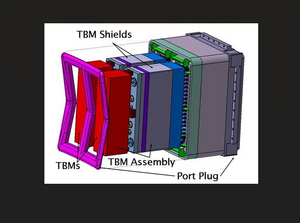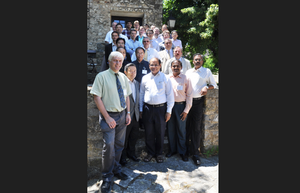Toward a common basis for TBM systems
1 Jul 2011
-
Krista Dulon
Equatorial ports numbers 2, 16, and 18 will be dedicated to Test Blanket Systems; each port will house two TBM concepts.
Of the 18 equatorial openings, or ports, into the ITER vacuum vessel, three will be dedicated to the testing of Test Blanket Modules (TBMs)—those ITER in-vessel components that will test viable techniques for "breeding" tritium within the fusion reactor.
ITER will provide a unique opportunity to test tritium breeding concepts. "A first version of experiments with six TBM concepts will start at the beginning of the first, pure-hydrogen phase of ITER operation," explains Luciano Giancarli, the Chief Technical Officer of the TBM Program. "and then, up to three other versions per TBM will be tested during the further phases of operation."
For the fusion power plants of the future that must be self-sufficient in tritium fuel (see box below), the data gathered from these experiments will be essential.
The Test Blanket Modules plus ancillary systems (cooling, tritium extraction, measurement ...) make up the Test Blanket Systems. Currently under design, these systems were the focus this week of a workshop attended by representatives of the seven ITER Members and the ITER Organization.
"Although each TBM design is distinct," explains Luciano, who chaired the workshop, "it is important to be on the same page for many parameters. This week's workshop focused on the interfaces that will exist between the Test Blanket Systems and ITER's instrumentation and control systems."
ITER's Test Blanket Systems will be connected to three types of control/measuring systems: CODAC, the "orchestrator" of the ITER machine; the central interlock system (CIS) dedicated to machine protection (investment protection); and the central safety system (CSS) for the protection of personnel and the environment. The interfaces with the CIS and CSS systems were the subject of discussions this week.
Chairman Luciano Giancarli (front left), Chief Technical Officer of the TBM Program, and participants in the workshop on functional interfaces between Test Blanket Systems and ITER CIS and CSS networks.
"As an experimental program, our TBM systems will all be equipped with measurement systems to determine how they behave—that is, after all, the research objective of this program," explains Luciano. "However, monitoring systems during accidental situations must also be agreed upon for investment protection and safety ..."
"This workshop, which gathered more than 30 experts, was a first step toward establishing a common basis for all six Test Blanket Systems," says Luciano. "It has allowed us to identify in a coherent manner the main accidents to be dealt with, and to require similar actions from the CIS and CSS systems to mitigate them for all the six Test Blanket Systems."
What kind of incidents might occur within the TBM systems? A loss of coolant or a decrease in the coolant rate of flow, for example, could indicate a ruptured pipe or an anomaly in the pumping system. Reacting quickly to such an incident would limit the consequences for the machine or for safety, whereas a slow reaction might result in damage and/or delay.
Measuring systems integrated into the TBM systems will transmit data by optical fibre or digital signal. "We don't need a thousand measurements," says Luciano, "but we do need measurements that are simple, reliable, and independent." In the case of serious incident, the CIS and/or CSS systems will have the ability to stop the plasma.
The goal during this week's workshop was to decide together on which events or incidents to plan for, which locations for the measuring systems would be best for detection, and what corrective actions must be planned in the case of incident.
"This workshop, which gathered more than 30 experts, was a first step toward establishing a common basis for all six Test Blanket Systems," says Luciano. "It has allowed us to identify in a coherent manner the main accidents to be dealt with, and to require similar actions from the CIS and CSS systems to mitigate them for all the six Test Blanket Systems."



